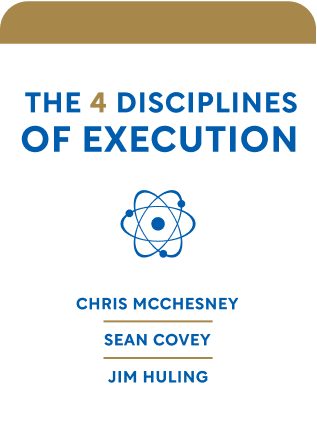

This article is an excerpt from the Shortform book guide to "The 4 Disciplines of Execution" by Chris McChesney, Sean Covey, and Jim Huling. Shortform has the world's best summaries and analyses of books you should be reading.
Like this article? Sign up for a free trial here .
Do you need to determine your 4DX lead measures? How can your measures support your wildly important goals?
Once you have goals, you need measures to achieve progress on those goals. The 4DX lead measures are the key indicators of progress. They can be developed using a four-step process.
Keep reading for the four-step process for developing 4DX lead measures.
Developing 4DX Lead Measures
Finding 4DX lead measures can be challenging. If you’re trying to do something you’ve never tried before, you have to do new things. How do you know what these new things should be? Like coming up with a WIG, there’s a four-step process:
Step 1: Brainstorm a List of Possible 4DX Lead Measures
Like step 1 of WIG brainstorming, come up with as many ideas as possible. The most effective lead measures may not be the ones that first occur to you. Make sure you focus on ideas that will help achieve the WIG. You’re not looking for a catch-all list of things it would be good to do. Coming up with lead measures requires a bit of that Discipline 1 focus.
While brainstorming, consider:
- What have we never done before that will help achieve the WIG?
- What are we good at that we can use to achieve the WIG?
- What are we bad at that might get in the way of us achieving the WIG?
- What are the activities we already do that are most important to achieve the WIG? Keep in mind the 80/20 rule—80% of your results will come from the top 20% of your actions. Choose your lead measures from these top activities.
- What did other people or companies with similar WIGs do? What were their lead measures?
Step 2: Assess Impact
Determine which lead measures will have the most impact on the team WIG. Probably all the ideas you come up with are good ideas, and you and team members feel like you should be doing all of them, but don’t fall into this trap—pick just a couple.
Step 3: Test the Top Candidates for 4DX Lead Measures
Test each potential lead measure. If the answers to all of the following questions are yes, the lead measure passes the test. Four of the questions are the same as in the WIG test, noted with an asterisk (*).
- Is it predictive? Will the lead measure influence the lag measure?
- *Can your team achieve the WIG without significant help from another team? (Is it influenceable?)
- Is it maintainable? The goal of a lead measure is to make new behaviors a habit. Therefore, ongoing processes are a better choice than one-offs.
- Ongoing processes: Attend all meetings of the volunteer executive.
- One-off: Sign up to be a member of a volunteer executive.
- *Are the results driven by the team rather than the leader? The team needs to engage with the measure or they won’t be interested.
- Weak lead measure: A leader more frequently audits.
- Strong lead measure: A team responds to audit findings.
- *Is there a way to measure it? You have to be able to measure the lead measures.
- Is the lead measure worthy of the effort it will take to carry out and measure? The lead measure must create enough impact to be worth the trouble, and shouldn’t have any negative side effects
- For example, a fast-food chain hired inspectors to visit restaurants. All the workers thought the inspectors were spies and morale dropped.
Step 4: Write the Lead Measures in their Final Form
When writing your 4DX lead measures in their final form, consider the following, and be specific. The considerations that are the same as for the WIG are noted with an asterisk (*).
Individual vs. team?
- If you track individual performance, you create a high level of accountability, but it’s harder to get perfect results because everyone has to meet the same standard. This requires detailed scorekeeping.
- For example, each person must sign up two people for the customer loyalty program per day
- If you track team performance, you allow differences in performance between team members, but it’s easier to achieve results because team members can make up for each other’s weaknesses (not necessarily a good thing—low performers can hide).
- For example, the whole team must collectively sign up ten people for the customer loyalty program per day
Daily or weekly? (Weekly is the minimum.)
- If you track daily, you create the highest level of accountability because each day must be the same
- For example, sign up two customers per day per team member
- If you track weekly, this allows for variability between days but you’ll still get the same numbers at the end of the week as you would have by tracking daily.
- For example, sign up 14 people per week per team member
How much and how often? Come up with numerical values for your lead measures. Pick numbers that are challenging but not impossible. When making this decision, keep the following in mind:
- Choose higher numbers if it’s a matter of safety. For example, Erasmus swabs 100% of every patient admitted to the hospital because the only acceptable number of hospital-acquired infections for them is zero.
- Use trial and error to land on appropriate numbers. For example, a building-materials client sent out two emails every week before a sale but didn’t get much response. They tried sending out three emails, and it was the magic number.
- Remember that more isn’t always better. For example, for a long time, drug companies very regularly visited docs. Doctors got so tired of them they banished salespeople from their offices.
How well? This is optional, but the best lead measures go beyond numerical values and have a quality component.
- If your lead measure is something your team already does, they have to do it much better than they currently are in order for it to move the lag measure
- For example, a sales team might have a lead measure of: “Upsell the all-inclusive package to four vacationers per week per team member.” The lead measure could additionally include direction about how well each team member must pitch: “Using our proven script, upsell the all-inclusive package to four vacationers per week per team member.”
*Start with a simple verb
- Good: Call five clients…
- Bad: Communicate via telephone…
*Be concrete, precise, and simple
- Good: Sell five pairs of shoes per team member per day.
- Bad: With the goal of increasing profit, sell… (Avoid any how-to language—your WIG already covers why you’re doing things.)
Yield
After implementing Discipline 2, you’ll come out with a short list of 4DX lead measures that will drive the WIG’s lag measure.

———End of Preview———
Like what you just read? Read the rest of the world's best book summary and analysis of Chris McChesney, Sean Covey, and Jim Huling's "The 4 Disciplines of Execution" at Shortform .
Here's what you'll find in our full The 4 Disciplines of Execution summary :
- The 4 disciplines that can make any strategy a successful reality
- Why a great plan falls apart when you don't think adequately about execution
- The 6 steps you need to scale the 4DX model across an entire organization






